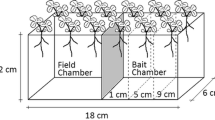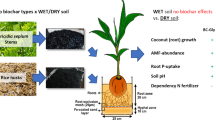Abstract
Soil born fungi such as Phytium ultimum, Fusarium ssp., and Rhizoctonia solani (Kühn) severely restrict stand establishment of common bean (Phaseolus vulgaris L.) on acid soils of the Tropics. Calcium application is known to alleviate fungal infection in many legumes but the causes are still unclear. To investigate environmental factors and physiological mechanisms involved, growth chamber experiments were conducted with an acid sandy soil from Mexico. Treatments were soil liming at a rate of 0.67 g Ca(OH)2 kg-1, gypsum application at 0.49 g CaSO4 2H2O kg-1 soil placed around the seed, and an untreated control. Beans were grown under three temperature regimes with constant night and one constant day vs. two sinusoidal day temperatures. To examine patterns of seed and seedling exudation at regular intervals leachates of germinating seeds were collected on filter paper soaked with equilibrium solutions from soils of the three treatments. The severity of root rot in the control treatment was highest when plants were stressed by temperature extremes. At a sinusoidal day temperature peaking at 40°C soil liming and gypsum application to the seed increased the number of healthy seedlings similarly by over 60%. However, only liming which effectively eliminated growth constraints by low pH and high aluminum concentrations led to an increase in hypocotyl elongation by 22% and in total root length by 8%. Both calcium amendments increased the calcium and potassium contents in the hypocotyl tissue. From seeds exposed to the equilibrium solution of unlimed soil with pH 3.7, 1 mM Ca, and 0.6 mM Al considerable amounts of amino acids and carbohydrates were leached. In contrast, exposure to the equilibrium solution from limed soil with pH 4.3, 3 mM Ca, and negligible concentrations of Al led to a net uptake of amino acids and decreased leaching of carbohydrates. Exposure to the equilibrium solution of the gypsum treatment with pH 3.6, 20 mM Ca, and 1.2 mM Al resulted in a somewhat smaller net uptake of amino acids compared to liming. During germination pH around the seeds steeply increased in the untreated control but significantly less with both amendments. The results indicate that pH and the Ca/Al ratio in the soil solution around bean seeds determine their pattern of exudation and solute uptake. For bean germination and early growth on acid soils locally placed application of small amounts of gypsum as seed pelleting seems as effective as soil liming in reducing the incidence of root rot. The results indicate that this may be accomplished by decreasing the amount of leachates available for fungal development.
Similar content being viewed by others
References
Adams J F and Hartzog D L 1991 Seed quality of runner peanuts at affected by gypsum and soil calcium. J. Plant Nutr. 14, 841–851.
Asher C 1987 Crop nutrition during the establishment phase: Role of seed reserves. In Proceedings of a Crop Establishment Workshop. Eds. I M Wood, W H Hazard and F R From. pp 88–106. Aust. Inst. Agr. Sci. Occ. Publ. No. 34.
Bateman D F and Lumsden R D 1965 Relation of calcium content and nature of the pectic substances in bean hypocotyls of different ages to susceptibility to an isolate of Rhizoctonia solani. Phytopathology 55, 734–738.
Bewley J D 1986 Membrane changes in seeds as related to germination and the perturbations resulting from deterioration in storage. In Physiology of Seed Deterioration. Eds. M B McDonald Jr and C J Nelson. pp 27–45. CSSA Spec. Pub. No. 11, Madison, WI.
Blakeney A B and Mutton L L 1980 A simple colorimetric method for the determination of sugars in fruit and vegetables. J. Sci. Food Agric. 31, 889–897.
Buerkert A, Cassman K G, de laPiedra R and Munns D N 1990 Soil acidity and liming effects on stand, nodulation, and yield of common bean. Agron. J. 82, 749–754.
Cameron R S, Ritchie G S P and Robson A D 1986 Relative toxicities of inorganic aluminum complexes to barley. Soil Sci. Soc. Am. J. 50, 1231–1236.
Castrano J J and Kernkamp M F 1956 The influence of certain plant nutrients on infection of soybeans by Rhizoctonia solani. Phytopathology 46, 326–328.
Csinos A S and Gaines T P 1986 Peanut pod rot complex: A geocarposphere nutrient imbalance. Plant Disease 70, 525–529.
D'Arcy A L 1982 Étude des exsudats racinaires de soja et de lentille. I. Cinétique d'exsudation des composés phénoliques, des amino acides et des sucres, au cours des premiers jours de la vie des plantules. Plant and Soil 68, 399–403.
Hale M G, Foy C L and Shay F J 1971 Factors affecting root exudation. Adv. Agron. 23, 89–109.
Hallock D L 1980 Soil or foliar applied nutrient effects on mineral concentrations and germinability of peanut seed. Peanut Sci. 7, 50–54.
Harris H C and Brolmann J B 1966 Comparison of calcium and boron deficiencies of the peanut. II. Seed quality in relation to histology and viability. Agron. J. 58, 578–582.
Hayman D, Schroth M N, Weinhold A R and Ashelm A 1966 Effect of temperature on exudation from cotton and bean seed. Phytopathology 56, 148 (Abstr.)
Helms K and David D J 1973 Far red and white light-promoted utilization of calcium by seedlings of Phaseolus vulgaris L. Plant Physiol. 51, 37–42.
Kleinig C R 1965 Emergence of Medicago tribuloides on moderately acid soils. Aust. J. Agric. Res. 16, 311–319.
Konno H, Yamaya T, Yamasaki Y and Matsumoto H 1984 Pectic polysaccharide breakdown of cell walls in cucumber roots grown with calcium starvation. Plant Physiol. 76, 633–637.
Kraft M and Erwin D C 1967 Stimulation of Pythium aphanidermatum by exudates from mung bean seeds. Phytopathology 57, 866–868.
Kuan T L and Erwin D C 1980. Predisposition effect of water saturation of soil on Phytophthora root rot of alfalfa. Phytopathology 70, 981–986.
Lee Y P and Takahashi T 1966 An improved colorimetric determination of amino acids with the use of ninhydrin. Anal. Biochem. 14, 71–77.
Mackenzie J, Glasby T and Diatloff A 1972 The role of nodulation and damping-off in lucerne establishment on acidic sandy soils on the Darling Downs. Aust. J. of Exp. Agric. and Animal Husbandry 12, 428–432.
Marschner H 1986 Mineral Nutrition of Higher Plants. Academic Press, London. 674 p.
Marschner H and Römheld V 1983 In vivo measurement of root induced pH changes at the root-soil interface: Effect of plant species and nitrogen source. Z. Pflanzenphysiol. 111, 241–251.
Muchovej R M C and Muchovej J J 1982 Calcium suppression of Sclerotium-induced twin stem abnormality of soybean. Soil Sci. 134, 181–184.
Nelson E B 1990 Exudate molecules initiating fungal responses to seeds and roots. Plant and Soil 129, 61–73.
Prasad K and Weigle J L 1976 Association of seed coat factors with resistance to Rhizoctonia solani in Phaseolus vulgaris. Phytopathology 66, 342–345.
Rovira A D 1969 Plant exudates. The Bot. Rev. 35, 35–57.
SAS Institute Inc. 1986 System for Linear Models. pp 92–93. SAS Inst., Inc. Cary, NC.
Smucker A J M and Erickson A E 1987 Anaerobic stimulation of root exudates and disease of peas. Plant and Soil 99, 423–433.
Schobert C and Komor E 1987 Amino acid uptake by Ricinus communis roots: Characterization and physiological significance. Plant Cell Environ. 10, 493–500.
Schroth M N and Cook R J 1964 Seed exudation and its influence on pre-emergence damping-off of beans. Phytopathology 54, 670–673.
Schroth M N and Snyder W C 1961 Effect of host exudates on chlamydospore germination of the bean root rot fungus, Fusarium solani f. phaseoli. Phytopathology 51, 389–393.
Schroth M N, Tousson T A and Snyder W C 1963 Effect of certain constituents of bean exudate on germination of chlamydospores of Fusarium solani f. phaseoli in soil. Phytopathology 53, 809–812.
Schubert S, Schubert E and Mengel K 1990 Effect of low pH of the root medium on proton release, growth, and nutrient uptake of field beans (Vicia faba). Plant and Soil 124, 239–244.
Shephard M C and Wood R K S 1963 The effect of environment, and nutrition of pathogen and host, in the damping off of seedlings and Rhizoctonia solani. Ann. Appl. Biol. 51, 389–402.
Simon E W and Raja Harun R M 1972 Leakage during seed imbibition. J. Exp. Bot. 23, 1076–1085.
Spain J M, Francis C A, Howeler R H and Calvo F 1975 Differential species and varietal tolerance to soil acidity in tropical crops and pastures. In Soil Management in Tropical America. Eds. EBornemisza and AAlvarado. pp 308–347. CIAT, Cali, Colombia.
Tennant D 1975 A test of a modified line intersection method of estimating root length. J. Ecol. 63, 995–1001.
Welch R M 1986 Effects of nutrient deficiencies on seed production and quality. In advances in Plant Nutrition. Eds. BTinker and ALäuchli. pp 205–247. Praeger Scientific, New York.
Author information
Authors and Affiliations
Rights and permissions
About this article
Cite this article
Buerkert, A., Marschner, H. Calcium and temperature effects on seedling exudation and root rot infection of common bean on an acid sandy soil. Plant Soil 147, 293–303 (1992). https://doi.org/10.1007/BF00029081
Received:
Issue Date:
DOI: https://doi.org/10.1007/BF00029081




